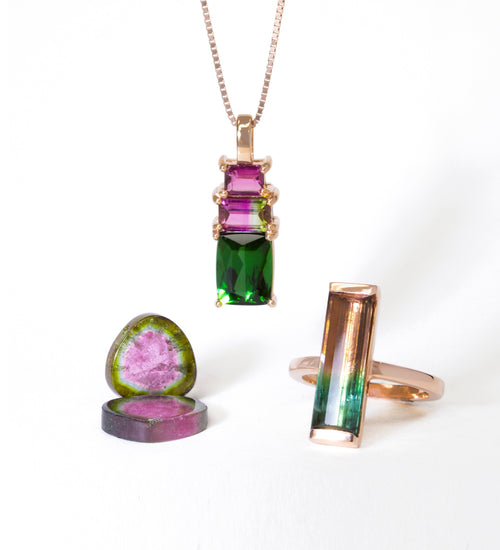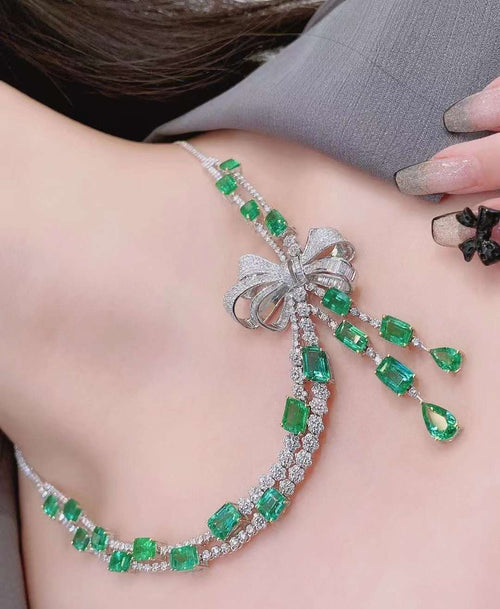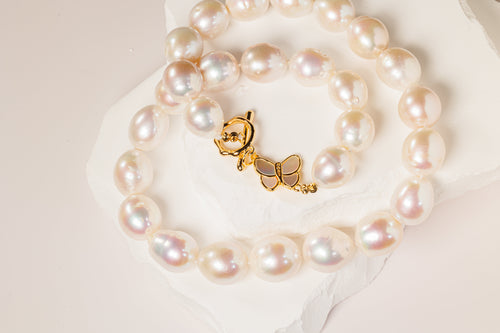Questions about products? Email/call us to schedule a free LIVE session for a custom shopping experience!
Understanding 18k Gold: What Does This Mean?
When shopping for jewelry, you may encounter terms like "18k gold" or "18 karat," which refer to the purity and composition of the gold used in the piece. Let's explore the meaning behind 18k gold and why it's a popular choice for fine jewelry.
What is 18k Gold?
The term "18k gold" is a measurement of purity and is defined as 18 parts pure gold out of a total of 24 parts. In percentage terms, 18k gold is composed of 75% pure gold (represented by the symbol Au) and 25% other metals, which are typically alloyed with gold to enhance its strength and durability. The use of alloy metals also influences the color of the gold, allowing for variations such as yellow gold, white gold, and rose gold.
Comparing 14k Gold vs. 18k Gold
-
Purity: 18k gold contains a higher percentage of pure gold (75%) compared to 14k gold, which contains 58.5% pure gold. As a result, 18k gold has a richer and deeper color.
-
Durability: While both 14k and 18k gold are durable enough for everyday wear, 14k gold is slightly harder and more scratch-resistant due to its higher alloy content.
-
Color: 18k gold tends to have a more vibrant and saturated color due to its higher gold content, whereas 14k gold may appear slightly lighter in color.
18k Gold vs. Gold-Plated Products
It's important to differentiate between solid 18k gold and gold-plated products:
-
Solid 18k Gold: Solid gold jewelry is made entirely of 18k gold, ensuring longevity and durability. It retains its value over time and can be passed down as heirloom pieces.
-
Gold-Plated Products: Gold-plated jewelry, on the other hand, consists of a base metal (such as brass or sterling silver) that is coated with a thin layer of gold through a process called electroplating. While gold-plated jewelry is more affordable, the gold layer may wear off over time with regular use.
-
Rhodium Plating vs. Gold Plating: What's the Difference?
Rhodium Plating:
-
Material and Process: Rhodium plating involves electroplating a thin layer of rhodium onto the surface of jewelry items. Rhodium is a precious metal belonging to the platinum group, known for its brilliant white color and exceptional hardness.
-
Appearance: Rhodium plating gives jewelry a bright and reflective finish, similar to platinum or white gold. It enhances the luster of the underlying metal and provides a protective barrier against scratches and tarnishing.
-
Durability: Rhodium is highly durable and resistant to corrosion, making it an excellent choice for enhancing the longevity of jewelry pieces. However, rhodium plating may wear off over time with regular wear, requiring periodic re-plating to maintain its appearance.
-
Common Uses: Rhodium plating is commonly used on white gold jewelry to enhance its whiteness and on sterling silver jewelry to prevent tarnishing and improve its appearance.
Gold Plating:
-
Material and Process: Gold plating involves depositing a thin layer of gold onto the surface of jewelry items through electroplating or chemical bonding processes. The underlying metal, known as the base metal, can be made of various materials such as brass, copper, or sterling silver.
-
Appearance: Gold plating provides jewelry with a luxurious and decorative gold finish. The thickness of the gold layer can vary, ranging from flash plating (thin layer) to heavy plating (thicker layer).
-
Durability: The durability of gold plating depends on the thickness of the gold layer and the base metal used. Thicker gold plating tends to be more durable and longer-lasting, but it may still wear off over time with frequent wear and exposure to moisture and chemicals.
-
Common Uses: Gold plating is widely used in fashion jewelry and costume jewelry to create affordable pieces with a gold-like appearance. It can be found in various colors, including yellow gold, rose gold, and white gold.
Which One Should You Choose?
-
For Whiteness and Durability: If you prefer a bright white finish that resembles platinum or white gold and offers exceptional durability, rhodium plating is an excellent choice.
-
For Gold-Like Appearance: If you desire the luxurious look of gold without the high cost of solid gold jewelry, gold plating is a budget-friendly option that allows you to enjoy different gold colors and styles.
-
Caring for Your 18k Gold Jewelry
To preserve the beauty and shine of your 18k gold jewelry, follow these care tips:
-
Regular Cleaning: Gently clean your jewelry using a soft brush and mild soap in warm water. Dry with a soft cloth to avoid scratching.
-
Avoid Harsh Chemicals: Remove your jewelry before swimming or using household cleaners to prevent damage to the metal.
-
Proper Storage: Store your gold jewelry in a fabric-lined jewelry box or pouch to prevent scratches and tangling.
In conclusion, 18k gold represents a luxurious and enduring choice for fine jewelry, offering a balance of purity, durability, and beauty. Whether you prefer the classic elegance of yellow gold, the modern appeal of white gold, or the romantic blush of rose gold, 18k gold jewelry is a timeless investment that will always make a statement.




